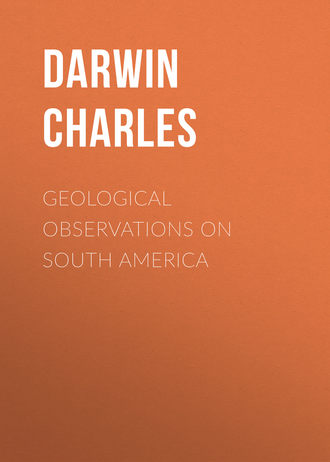 полная версия
полная версияGeological Observations on South America
ON THE ABSENCE OF EXTENSIVE MODERN CONCHIFEROUS DEPOSITS IN SOUTH AMERICA; AND ON THE CONTEMPORANEOUSNESS OF THE OLDER TERTIARY DEPOSITS AT DISTANT POINTS BEING DUE TO CONTEMPORANEOUS MOVEMENTS OF SUBSIDENCE.
Knowing from the researches of Professor E. Forbes, that molluscous animals chiefly abound within a depth of 100 fathoms and under, and bearing in mind how many thousand miles of both coasts of South America have been upraised within the recent period by a slow, long-continued, intermittent movement, – seeing the diversity in nature of the shores and the number of shells now living on them, – seeing also that the sea off Patagonia and off many parts of Chile, was during the tertiary period highly favourable to the accumulation of sediment, – the absence of extensive deposits including recent shells over these vast spaces of coast is highly remarkable. The conchiferous calcareous beds at Coquimbo, and at a few isolated points northward, offer the most marked exception to this statement; for these beds are from twenty to thirty feet in thickness, and they stretch for some miles along shore, attaining, however, only a very trifling breadth. At Valdivia there is some sandstone with imperfect casts of shells, which POSSIBLY may belong to the recent period: parts of the boulder formation and the shingle-beds on the lower plains of Patagonia probably belong to this same period, but neither are fossiliferous: it also so happens that the great Pampean formation does not include, with the exception of the Azara, any mollusca. There cannot be the smallest doubt that the upraised shells along the shores of the Atlantic and Pacific, whether lying on the bare surface, or embedded in mould or in sand-hillocks, will in the course of ages be destroyed by alluvial action: this probably will be the case even with the calcareous beds of Coquimbo, so liable to dissolution by rain-water. If we take into consideration the probability of oscillations of level and the consequent action of the tidal-waves at different heights, their destruction will appear almost certain. Looking to an epoch as far distant in futurity as we now are from the past Miocene period, there seems to me scarcely a chance, under existing conditions, of the numerous shells now living in those zones of depths most fertile in life, and found exclusively on the western and south-eastern coasts of South America, being preserved to this imaginary distant epoch. A whole conchological series will in time be swept away, with no memorials of their existence preserved in the earth's crust.
Can any light be thrown on this remarkable absence of recent conchiferous deposits on these coasts, on which, at an ancient tertiary epoch, strata abounding with organic remains were extensively accumulated? I think there can, namely, by considering the conditions necessary for the preservation of a formation to a distant age. Looking to the enormous amount of denudation which on all sides of us has been effected, – as evidenced by the lofty cliffs cutting off on so many coasts horizontal and once far-extended strata of no great antiquity (as in the case of Patagonia), – as evidenced by the level surface of the ground on both sides of great faults and dislocations, – by inland lines of escarpments, by outliers, and numberless other facts, and by that argument of high generality advanced by Mr. Lyell, namely, that every SEDIMENTARY formation, whatever its thickness may be, and over however many hundred square miles it may extend, is the result and the measure of an equal amount of wear and tear of pre-existing formations; considering these facts, we must conclude that, as an ordinary rule, a formation to resist such vast destroying powers, and to last to a distant epoch, must be of wide extent, and either in itself, or together with superincumbent strata, be of great thickness. In this discussion, we are considering only formations containing the remains of marine animals, which, as before mentioned, live, with some exceptions within (most of them much within) depths of 100 fathoms. How, then, can a thick and widely extended formation be accumulated, which shall include such organic remains? First, let us take the case of the bed of the sea long remaining at a stationary level: under these circumstances it is evident that CONCHIFEROUS strata can accumulate only to the same thickness with the depth at which the shells can live; on gently inclined coasts alone can they accumulate to any considerable width; and from the want of superincumbent pressure, it is probable that the sedimentary matter will seldom be much consolidated: such formations have no very good chance, when in the course of time they are upraised, of long resisting the powers of denudation. The chance will be less if the submarine surface, instead of having remained stationary, shall have gone on slowly rising during the deposition of the strata, for in this case their total thickness must be less, and each part, before being consolidated or thickly covered up by superincumbent matter, will have had successively to pass through the ordeal of the beach; and on most coasts, the waves on the beach tend to wear down and disperse every object exposed to their action. Now, both on the south-eastern and western shores of South America, we have had clear proofs that the land has been slowly rising, and in the long lines of lofty cliffs, we have seen that the tendency of the sea is almost everywhere to eat into the land. Considering these facts, it ceases, I think, to be surprising, that extensive recent conchiferous deposits are entirely absent on the southern and western shores of America.
Let us take the one remaining case, of the bed of the sea slowly subsiding during a length of time, whilst sediment has gone on being deposited. It is evident that strata might thus accumulate to any thickness, each stratum being deposited in shallow water, and consequently abounding with those shells which cannot live at great depths: the pressure, also, I may observe, of each fresh bed would aid in consolidating all the lower ones. Even on a rather steep coast, though such must ever be unfavourable to widely extended deposits, the formations would always tend to increase in breadth from the water encroaching on the land. Hence we may admit that periods of slow subsidence will commonly be most favourable to the accumulation of CONCHIFEROUS deposits, of sufficient thickness, extension, and hardness, to resist the average powers of denudation.
We have seen that at an ancient tertiary epoch, fossiliferous deposits were extensively deposited on the coasts of South America; and it is a very interesting fact, that there is evidence that these ancient tertiary beds were deposited during a period of subsidence. Thus, at Navidad, the strata are about eight hundred feet in thickness, and the fossil shells are abundant both at the level of the sea and some way up the cliffs; having sent a list of these fossils to Professor E. Forbes, he thinks they must have lived in water between one and ten fathoms in depth: hence the bottom of the sea on which these shells once lived must have subsided at least 700 feet to allow of the superincumbent matter being deposited. I must here remark, that, as all these and the following fossil shells are extinct species, Professor Forbes necessarily judges of the depths at which they lived only from their generic character, and from the analogical distribution of shells in the northern hemisphere; but there is no just cause from this to doubt the general results. At Huafo the strata are about the same thickness, namely, 800 feet, and Professor Forbes thinks the fossils found there cannot have lived at a greater depth than fifty fathoms, or 300 feet. These two points, namely, Navidad and Huafo, are 570 miles apart, but nearly halfway between them lies Mocha, an island 1,200 feet in height, apparently formed of tertiary strata up to its level summit, and with many shells, including the same Turritella with that found at Huafo, embedded close to the level of the sea. In Patagonia, shells are numerous at Santa Cruz, at the foot of the 350 feet plain, which has certainly been formed by the denudation of the 840 feet plain, and therefore was originally covered by strata that number of feet in thickness, and these shells, according to Professor Forbes, probably lived at a depth of between seven and fifteen fathoms: at Port S. Julian, sixty miles to the north, shells are numerous at the foot of the ninety feet plain (formed by the denudation of the 950 feet plain), and likewise occasionally at the height of several hundred feet in the upper strata; these shells must have lived in water somewhere between five and fifty fathoms in depth. Although in other parts of Patagonia I have no direct evidence of shoal-water shells having been buried under a great thickness of superincumbent submarine strata, yet it should be borne in mind that the lower fossiliferous strata with several of the same species of Mollusca, the upper tufaceous beds, and the high summit-plain, stretch for a considerable distance southward, and for hundreds of miles northward; seeing this uniformity of structure, I conceive it may be fairly concluded that the subsidence by which the shells at Santa Cruz and S. Julian were carried down and covered up, was not confined to these two points, but was co-extensive with a considerable portion of the Patagonian tertiary formation. In a succeeding chapter it will be seen, that we are led to a similar conclusion with respect to the secondary fossiliferous strata of the Cordillera, namely, that they also were deposited during a long- continued and great period of subsidence. From the foregoing reasoning, and from the facts just given, I think we must admit the probability of the following proposition: namely, that when the bed of the sea is either stationary or rising, circumstances are far less favourable, than when the level is sinking, to the accumulation of CONCHIFEROUS deposits of sufficient thickness and extension to resist, when upheaved, the average vast amount of denudation. This result appears to me, in several respects, very interesting: every one is at first inclined to believe that at innumerable points, wherever there is a supply of sediment, fossiliferous strata are now forming, which at some future distant epoch will be upheaved and preserved; but on the views above given, we must conclude that this is far from being the case; on the contrary, we require (1st), a long-continued supply of sediment; (2nd), an extensive shallow area; and (3rd), that this area shall slowly subside to a great depth, so as to admit the accumulation of a widely extended thick mass of superincumbent strata. In how few parts of the world, probably, do these conditions at the present day concur! We can thus, also, understand the general want of that close sequence in fossiliferous formations which we might theoretically have anticipated; for, without we suppose a subsiding movement to go on at the same spot during an enormous period, from one geological era to another, and during the whole of this period sediment to accumulate at the proper rate, so that the depth should not become too great for the continued existence of molluscous animals, it is scarcely possible that there should be a perfect sequence at the same spot in the fossil shells of the two geological formations. (Professor H.D. Rogers, in his excellent address to the Association of American Geologists ("Silliman's Journal" volume 47 page 277) makes the following remark: "I question if we are at all aware how COMPLETELY the whole history of all departed time lies indelibly recorded with the amplest minuteness of detail in the successive sediments of the globe, how effectually, in other words, every period of time HAS WRITTEN ITS OWN HISTORY, carefully preserving every created form and every trace of action." I think the correctness of such remarks is more than doubtful, even if we except (as I suppose he would) all those numerous organic forms which contain no hard parts.) So far from a very long-continued subsidence being probable, many facts lead to the belief that the earth's surface oscillates up and down; and we have seen that during the elevatory movements there is but a small chance of DURABLE fossiliferous deposits accumulating.
Lastly, these same considerations appear to throw some light on the fact that certain periods appear to have been favourable to the deposition, or at least to the preservation, of contemporaneous formations at very distant points. We have seen that in South America an enormous area has been rising within the recent period; and in other quarters of the globe immense spaces appear to have risen contemporaneously. From my examination of the coral- reefs of the great oceans, I have been led to conclude that the bed of the sea has gone on slowly sinking within the present era, over truly vast areas: this, indeed, is in itself probable, from the simple fact of the rising areas having been so large. In South America we have distinct evidence that at nearly the same tertiary period, the bed of the sea off parts of the coast of Chile and off Patagonia was sinking, though these regions are very remote from each other. If, then, it holds good, as a general rule, that in the same quarter of the globe the earth's crust tends to sink and rise contemporaneously over vast spaces, we can at once see, that we have at distant points, at the same period, those very conditions which appear to be requisite for the accumulation of fossiliferous masses of sufficient extension, thickness, and hardness, to resist denudation, and consequently to last unto an epoch distant in futurity. (Professor Forbes has some admirable remarks on this subject, in his "Report on the Shells of the Aegean Sea." In a letter to Mr. Maclaren ("Edinburgh New Philosophical Journal" January 1843), I partially entered into this discussion, and endeavoured to show that it was highly improbable, that upraised atolls or barrier-reefs, though of great thickness, should, owing to their small extension or breadth, be preserved to a distant future period.)
CHAPTER VI. PLUTONIC AND METAMORPHIC ROCKS: – CLEAVAGE AND FOLIATION
Brazil, Bahia, gneiss with disjointed metamorphosed dikes.
Strike of foliation.
Rio de Janeiro, gneiss-granite, embedded fragment in, decomposition of.
La Plata, metamorphic and old volcanic rocks of.
S. Ventana.
Claystone porphyry formation of Patagonia; singular metamorphic rocks;
pseudo-dikes.
Falkland Islands, Palaeozoic fossils of.
Tierra del Fuego, clay-slate formation, cretaceous fossils of; cleavage and foliation; form of land.
Chonos Archipelago, mica-schists, foliation disturbed by granitic axis;
dikes.
Chiloe.
Concepcion, dikes, successive formation of.
Central and Northern Chile.
Concluding remarks on cleavage and foliation.
Their close analogy and similar origin.
Stratification of metamorphic schists.
Foliation of intrusive rocks.
Relation of cleavage and foliation to the lines of tension during metamorphosis.
The metamorphic and plutonic formations of the several districts visited by the "Beagle" will be here chiefly treated of, but only such cases as appear to me new, or of some special interest, will be described in detail; at the end of the chapter I will sum up all the facts on cleavage and foliation, – to which I particularly attended.
BAHIA, BRAZIL: latitude 13 degrees south.
The prevailing rock is gneiss, often passing, by the disappearance of the quartz and mica, and by the feldspar losing its red colour, into a brilliantly grey primitive greenstone. Not unfrequently quartz and hornblende are arranged in layers in almost amorphous feldspar. There is some fine-grained syenitic granite, orbicularly marked by ferruginous lines, and weathering into vertical, cylindrical holes, almost touching each other. In the gneiss, concretions of granular feldspar and others of garnets with mica occur. The gneiss is traversed by numerous dikes composed of black, finely crystallised, hornblendic rock, containing a little glassy feldspar and sometimes mica, and varying in thickness from mere threads to ten feet: these threads, which are often curvilinear, could sometimes be traced running into the larger dikes. One of these dikes was remarkable from having been in two or three places laterally disjointed, with unbroken gneiss interposed between the broken ends, and in one part with a portion of the gneiss driven, apparently whilst in a softened state, into its side or wall. In several neighbouring places, the gneiss included angular, well- defined, sometimes bent, masses of hornblende rock, quite like, except in being more perfectly crystallised, that forming the dikes, and, at least in one instance, containing (as determined by Professor Miller) augite as well as hornblende. In one or two cases these angular masses, though now quite separate from each other by the solid gneiss, had, from their exact correspondence in size and shape, evidently once been united; hence I cannot doubt that most or all of the fragments have been derived from the breaking up of the dikes, of which we see the first stage in the above- mentioned laterally disjointed one. The gneiss close to the fragments generally contained many large crystals of hornblende, which are entirely absent or rare in other parts: its folia or laminae were gently bent round the fragments, in the same manner as they sometimes are round concretions. Hence the gneiss has certainly been softened, its composition modified, and its folia arranged, subsequently to the breaking up of the dikes, these latter also having been at the same time bent and softened. (Professor Hitchcock "Geology of Massachusetts" volume 2 page 673, gives a closely similar case of a greenstone dike in syenite.)
I must here take the opportunity of premising, that by the term CLEAVAGE I imply those planes of division which render a rock, appearing to the eye quite or nearly homogeneous, fissile. By the term FOLIATION, I refer to the layers or plates of different mineralogical nature of which most metamorphic schists are composed; there are, also, often included in such masses, alternating, homogeneous, fissile layers or folia, and in this case the rock is both foliated and has a cleavage. By STRATIFICATION, as applied to these formations, I mean those alternate, parallel, large masses of different composition, which are themselves frequently either foliated or fissile, – such as the alternating so-called strata of mica-slate, gneiss, glossy clay-slate, and marble.
The folia of the gneiss within a few miles round Bahia generally strike irregularly, and are often curvilinear, dipping in all directions at various angles: but where best defined, they extended most frequently in a N.E. by N. (or East 50 degrees N.) and S.W. by S. line, corresponding nearly with the coast-line northwards of the bay. I may add that Mr. Gardner found in several parts of the province of Ceara, which lies between four and five hundred miles north of Bahia, gneiss with the folia extending E. 45 degrees N.; and in Guyana according to Sir R. Schomburgk, the same rock strikes E. 57 degrees N. Again, Humboldt describes the gneiss-granite over an immense area in Venezuela and even in Colombia, as striking E. 50 degrees N., and dipping to the N.W. at an angle of fifty degrees. (Gardner "Geological Section of the British Association" 1840. For Sir R. Schomburgk's observations see "Geographical Journal" 1842 page 190. See also Humboldt's discussion on Loxodrism in the "Personal Narrative.") Hence all the observations hitherto made tend to show that the gneissic rocks over the whole of this part of the continent have their folia extending generally within almost a point of the compass of the same direction. (I landed at only one place north of Bahia, namely, at Pernambuco. I found there only soft, horizontally stratified matter, formed from disintegrated granitic rocks, and some yellowish impure limestone, probably of a tertiary epoch. I have described a most singular natural bar of hard sandstone, which protects the harbour, in the 19th volume 1841 page 258 of the "London and Edinburgh Philosophical Magazine."
ABROLHOS ISLETS, Latitude 18 degrees S. off the coast of Brazil.
Although not strictly in place, I do not know where I can more conveniently describe this little group of small islands. The lowest bed is a sandstone with ferruginous veins; it weathers into an extraordinary honeycombed mass; above it there is a dark-coloured argillaceous shale; above this a coarser sandstone – making a total thickness of about sixty feet; and lastly, above these sedimentary beds, there is a fine conformable mass of greenstone, in some parts having a columnar structure. All the strata, as well as the surface of the land, dip at an angle of about 12 degrees to N. by W. Some of the islets are composed entirely of the sedimentary, others of the trappean rocks, generally, however, with the sandstone, cropping out on the southern shores.)
RIO DE JANEIRO.
This whole district is almost exclusively formed of gneiss, abounding with garnets, and porphyritic with large crystals, even three and four inches in length, of orthoclase feldspar: in these crystals mica and garnets are often enclosed. At the western base of the Corcovado, there is some ferruginous carious quartz-rock; and in the Tijeuka range, much fine- grained granite. I observed boulders of greenstone in several places; and on the islet of Villegagnon, and likewise on the coast some miles northward, two large trappean dikes. The porphyritic gneiss, or gneiss- granite as it has been called by Humboldt, is only so far foliated that the constituent minerals are arranged with a certain degree of regularity, and may be said to have a "GRAIN," but they are not separated into distinct folia or laminae. There are, however, several other varieties of gneiss regularly foliated, and alternating with each other in so-called strata. The stratification and foliation of the ordinary gneisses, and the foliation or "grain" of the gneiss-granite, are parallel to each other, and generally strike within a point of N.E. and S.W. dipping at a high angle (between 50 and 60 degrees) generally to S.E.: so that here again we meet with the strike so prevalent over the more northern parts of this continent. The mountains of gneiss-granite are to a remarkable degree abruptly conical, which seems caused by the rock tending to exfoliate in thick, conically concentric layers: these peaks resemble in shape those of phonolite and other injected rocks on volcanic islands; nor is the grain or foliation (as we shall afterwards see) any difficulty on the idea of the gneiss-granite having been an intrusive rather than a metamorphic formation. The lines of mountains, but not always each separate hill, range nearly in the same direction with the foliation and so-called stratification, but rather more easterly.
(FIGURE 22. FRAGMENT OF GNEISS EMBEDDED IN ANOTHER VARIETY OF THE SAME ROCK.)
On a bare gently inclined surface of the porphyritic gneiss in Botofogo Bay, I observed the appearance represented in Figure 22. A fragment seven yards long and two in width, with angular and distinctly defined edges, composed of a peculiar variety of gneiss with dark layers of mica and garnets, is surrounded on all sides by the ordinary gneiss- granite; both having been dislocated by a granitic vein. The folia in the fragment and in the surrounding rock strike in the same N.N.E. and S.S.W. line; but in the fragment they are vertical, whereas in the gneiss-granite they dip at a small angle, as shown by the arrows, to S.S.E. This fragment, considering its great size, its solitary position, and its foliated structure parallel to that of the surrounding rock, is, as far as I know, a unique case: and I will not attempt any explanation of its origin.
The numerous travellers in this country, have all been greatly surprised at the depth to which the gneiss and other granitic rocks, as well as the talcose slates of the interior, have been decomposed. (Spix and Martius have collected in an Appendix to their "Travels," the largest body of facts on this subject. See also some remarks by M. Lund in his communications to the Academy at Copenhagen; and others by M. Gaudichaud in Freycinet "Voyage.") Near Rio, every mineral except the quartz has been completely softened, in some places to a depth little less than one hundred feet. (Dr. Benza describes granitic rock, "Madras Journal of Literature" etc. October 183? page 246), in the Neelgherries, decomposed to a depth of forty feet.) The minerals retain their positions in folia ranging in the usual direction; and fractured quartz veins may be traced from the solid rock, running for some distance into the softened, mottled, highly coloured, argillaceous mass. It is said that these decomposed rocks abound with gems of various kinds, often in a fractured state, owing, as some have supposed, to the collapse of geodes, and that they contain gold and diamonds. At Rio, it appeared to me that the gneiss had been softened before the excavation (no doubt by the sea) of the existing, broad, flat-bottomed valleys; for the depth of decomposition did not appear at all conformable with the present undulations of the surface. The porphyritic gneiss, where now exposed to the air, seems to withstand decomposition remarkably well; and I could see no signs of any tendency to the production of argillaceous masses like those here described. I was also struck with the fact, that where a bare surface of this rock sloped into one of the quiet bays, there were no marks of erosion at the level of the water, and the parts both beneath and above it preserved a uniform curve. At Bahia, the gneiss rocks are similarly decomposed, with the upper parts insensibly losing their foliation, and passing, without any distinct line of separation, into a bright red argillaceous earth, including partially rounded fragments of quartz and granite. From this circumstance, and from the rocks appearing to have suffered decomposition before the excavation of the valleys, I suspect that here, as at Rio, the decomposition took place under the sea. The subject appeared to me a curious one, and would probably well repay careful examination by an able mineralogist.











